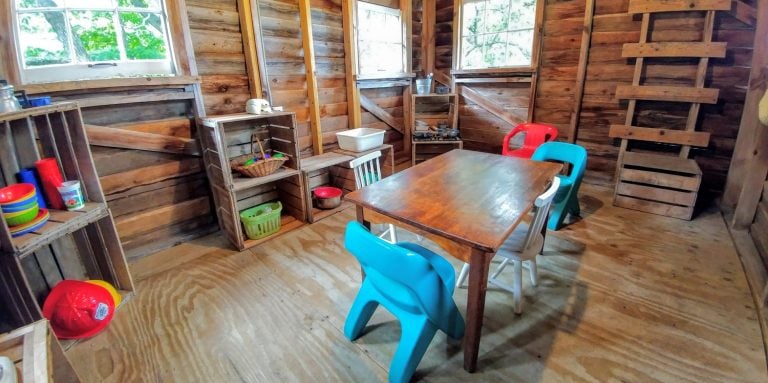Build a Treehouse without Harming Trees: 12 Tips & Tricks
A treehouse can be a fresh, relaxing space for both children and adults to enjoy; being high up in the canopy helps reconnect us with the nature around us. However, if you want to maintain that nature, you have to be careful about how you build a treehouse, so as not to cause any damage to the tree over time.
A treehouse can be built without harming the tree supporting it. A few tips and tricks for safe construction include:
- Picking a strong, healthy tree to support the construction
- Leaving the tree room to grow
- Protecting the tree’s bark
- Spreading out the treehouse’s hardware and weight
A treehouse can be as simple as a wooden platform a few feet off the ground, or it can be a wonderous masterpiece of craftsmanship and architectural design. Whatever your intended arboreal abode may be, it won’t last long if the tree supporting it is harmed. As you begin to construct your own sanctuary in the sky, here 12 tips and tricks to keep in mind to ensure the tree stays safe and healthy:
1. Plan Your Build
You may have had a treehouse as a kid, or at least dreamed of one, but treehouses are for everyone, adults included. In recent years, TV shows such as Treehouse Masters on Animal Planet and the DIY Network’s The Treehouse Guys have inspired people to channel their creativity into constructing a home amongst the leaves.
When designing your treehouse, your imagination, and the size of the tree, are the limits. Build your family a fabulous nature nook or entertain friends in an adults-only treetop speakeasy. If you can imagine it, it can be built. However, building it well is another matter.
A good treehouse is one that is well thought out. Rushing into any construction project will lead to frustration and put you at risk for injury. So, before the nails and screws go flying, a few things to consider doing are:
- Call an Arborist – A tree expert can tell you if your intended tree is sturdy, healthy, and will be around for a while.
- Check the Codes – Look into local building codes and regulations to make sure your plans don’t turn into a nightmare.
- Sketch Out the Plans – Creating your own blueprints will help keep things on track and help prevent a window being cut in the floor—unless you want it there, of course (more on blueprints later).
2. Pick the Right Type of Tree to Build in
Choosing the right type of tree to support your treehouse is critical, as it will determine the upper size and weight limit of the final structure.
Trees are sorted into two different groups:
- Coniferous Trees: trees that have leaves/needles all year round. Conifers can grow throughout the year, so their wood is softer and is breaks easier.
- Deciduous Trees: trees that drop their leaves in the fall and regrow them in the spring. Deciduous trees grow slower than conifers since they mostly grow in the spring and summer; the slower growth creates dense, durable wood.
Naturally, a deciduous tree will be the ideal option for building a treehouse in, since the wood is strong enough to support one; however, if you live in an area where the option to build in a deciduous tree isn’t available, don’t worry. Some conifers can take on the challenge of a treehouse, too.
Of course, besides the group the tree belongs to, you should also consider the genus/type. The following are some of the better varieties for building treehouses in:
- Oak – deciduous
- Maple – deciduous
- Apple – deciduous
- Beech – deciduous
- Hemlock – coniferous
- Cedar – coniferous
- Douglas Fir – coniferous
Other trees, such as cottonwood, willow, spruce, or birch, should be avoided. (Cottonwoods are notorious for dropping their branches as a propagation technique—something you certainly don’t want when your treehouse is below.)
Note: In North America, there are about 1,000 native tree species, so unless you are a botanist, you might not know a Sitka Spruce from Red Alder. To discover what trees you have near you or your backyard, take a look at a field guide, such as The Trees of North America or iNaturalist. For Europeans, here is a description of the most common genera.
Considering Tree Size
Since treehouses come in all shapes and sizes, and with different purposes, it gets a little tricky when deciding exactly how big your tree needs to be.
For a basic treehouse that is 8 feet by 8 feet, choose a tree with a trunk diameter of 12 inches or more where you will place the supports. If you are building in a grove of trees, or want a tree mansion, consider using multiple trees to support your structure.
In other words, the grander your design plans are, the bigger your tree needs to be to support it.
To measure the diameter of a tree trunk, take a measuring tape or a piece of string, and wrap it around the tree where the supports will be. Take the circumference measurement and divide it by pi (3.142) to calculate the tree’s diameter.
Remember, a tree’s trunk gets narrower the higher up it is. At ground level, a tree’s diameter might be large enough, but if you go up 12 feet, it might be too small.
Building in a tree that is too small to bear the weight of your treehouse and its support system can result in broken branches, or even snapped trunks.
Considering Tree Experience & Age
When you choose a tree to house your home, think about what that tree has experienced. If it has stood firm through blowing gales, icy freezes, and torrential downpours, then your tree can handle holding up your woodland escape, too.
When you build your treehouse, you are putting extra demand on that tree. You want to be sure it can handle the weather with the additional weight load, too.
Age of the Tree
Some trees have an average lifespan of 60 years, while others live for hundreds or even thousands of years. (The oldest known non-clonal tree is Methuselah, a Californian bristlecone pine, which will be celebrating its 5,000th birthday in just under 200 years.)
Trees grow at different rates, so a tree that meets the size requirements may still be relatively young. A young tree might not withstand a rare winter blizzard that an older tree has been through. On the other hand, while an ancient tree has made it through many weather events, it might not have much longer to live.
Ultimately, to ensure your tree stays safe, the tree you pick should have a delicate balance between its experience and age.
3. Check for Signs of Illness in the Tree
Trees, like other living organisms, can get infections; common causes of infection in trees are bacteria and fungi. Some infections kill a tree with no warning, such as sudden oak death, while other infections are slow and may take years to overpower the tree.
Building a treehouse in an already infected tree is dangerous for your family and will only cause more harm to the tree.
When you go out to examine your intended treehouse tree, it is critical that you look for signs of good and poor health. A sick tree might survive for a few years if left alone, but with the added stress of a treehouse, it can deteriorate much faster.
Signs of an unhealthy tree includes:
- Broken Branches – A few broken branches throughout the tree’s canopy is normal, but if you notice there are many broken branches, or they are all clustered together, this is a sign that the tree is weak.
- Leaning – A tree growing on flat ground should grow straight. Its trunk adapts to rise against the pull of gravity. If a tree is leaning or doesn’t look “normal,” go find a different tree to work with. Trees on hillsides that are prone to sliding will often grow in a “J” shape. Although those trees may be healthy, it’s not the safest place to build your getaway.
- Leaves – Observe the tree’s leaves; unhealthy signs include:
- No leaves during the spring or summer
- Spots or discoloration in the spring or summer
- Strange growth patterns such as abnormal clusters
- No flowers or fruit on deciduous trees
- Unusually small leaves
- Fungal Growth – Fungi are decomposers, which means they consume dead organic material. If you see mushrooms, conks, or other fungi, this is a sign that your tree is not healthy.
- Shoots – A healthy tree will have a trunk and branches. When a tree starts growing shoots, small branches coming from the bottom of the trunk, it is a sign that the tree is stressed. It is putting its energy into re-growing instead of sustaining the larger tree already standing.
- Lack of Bark – Select a tree that is not missing any bark. Those missing patches might be from animal activity, weed watchers or mowers, kids playing, or from an infection. The more bark that is missing from the tree, the more serious the damage.
- Dripping Sap – A tree’s sap should stay on the inside. If you see it oozing out of the bark, it is a sign there may be an infection.
As the property owner, the trees on your land are in your care. Knowing when they are unhealthy is essential, whether you plan to build a treehouse in them or not. Check out the Tree Health Guide from the Arbor Day Foundation to learn more about tree care.
If you are unsure about whether a tree is healthy or not, don’t hesitate to contact an arborist. They can help you understand what is going on with your trees and help you choose a healthy one to build in.
4. Make Sure Your Tree Has Room to Grow & Move
Young trees, called saplings, put most of their energy into growing tall, so they have more access to sunlight. As a tree matures, it shifts from growing up to growing out. To understand how a tree grows, take a look at the U.S. Forest Service’s video Ever Wonder How Trees Grow?.
Your treehouse will need to be bolted into the middle of the tree’s trunk. The center of a tree is called the heartwood, and this is where the strength of the tree is. As the tree grows, it will start to grow around the treehouse’s supports.
Over time, the tree’s outward expansion will encompass the supports attached to it. This isn’t bad for the tree, but it will disfigure its shape. To prevent disfigurement, add spacers between the trunk and the beam. The spacers will allow the tree to grow for longer before reaching the supports.
In addition to the tree’s natural growth, you need to think about movement. Even the slightest breeze will result in the swaying of the branches and trunk. Anywhere your treehouse will encompass the tree, space for movement needs to be included. Where the tree goes through the floor, roof, walls, or deck, leave 3 inches of space between the tree and the edge of the hole.
This extra space will allow the tree to bend and sway without damaging itself or your treehouse.
5. Keep the Tree’s Bark Protected
A tree’s bark is similar to a human’s skin. It is the barrier that keeps out pathogens and protects what is inside from the outside world. When the bark is damaged, the tree is put at risk of infection.
Cutting into or cutting out sections of the tree should be avoided. Directly under the bark are xylem and phloem tissues, which are veins that transport water, minerals, and sugars between the roots and the leaves. Any time a section is cut out from a tree, chunks of these tissues come with it. As more tissue is damaged or removed, the tree has less ability to perform its necessary processes for survival.
By building a treehouse, you are already adding weighted stress to the tree. If you then damage the tree’s bark and internal tissues, that tree won’t be able to support your treehouse for as long.
If there are a few smaller branches in the way of your construction, you can remove those branches without causing harm to the tree, as long as you prune them properly. The International Society of Arboriculture has information on tree pruning, health, and more.
Ropes, cables, and webbing are often used with good intentions. It seems like it would be less damaging to the tree than bolts, but it can be more harmful. The pressure and rubbing from these materials can strip off the bark and damage the delicate tissue underneath. If webbing or ropes are used, be sure to remove them for several months of the year to allow the tree to combat the strain.
6. Avoid the Roots
Damaging a tree’s roots is a sure way to stress it out, and a stressed tree is an unhealthy tree. When planning, constructing, and enjoying your treehouse, be aware of the tree’s roots. Two common ways to damage a tree’s roots are:
- Soil Compaction – repetitive walking or the use of machinery can compact the soil cutting of the roots’ access to water, oxygen, and nutrients.
- Soil Depth – a healthy tree’s roots are growing where they need to be. By adding or removing soil, the roots are no longer at the proper depth in the ground.
To minimize the damage done, be diligent, and plan ahead. You can decrease root damage by:
- Limiting the amount you walk over the root zone. The root zone is up to four times the area of the above-ground growth.
- Store tools and materials further away from the trunk of the tree.
- Don’t use or limit the use of heavy machinery around the tree.
Use woodchips or plants to designate pathways, so when people visit your treehouse, they know where to walk. If children will use your treehouse, create a safe play area, and tell them that trampling around the base of the tree can hurt its roots. They are sure to love their treehouse and tree and want to help keep it safe too.
If you notice that the ground is getting compacted, fence off that area and give it time to recuperate.
7. Spread Out the Treehouse’s Hardware
When a tree is injured, it does not heal the same way animals do. Instead, it seals off the damaged area to prevent infection in the healthy tissue. This process of sealing is called compartmentalization.
When building your treehouse, the tree can quickly seal off the damage done by a single bolt inserted into its trunk, but if many bolts are used or if they are placed too close together, the tree may not be successful in compartmentalizing the damage. Unsuccessful compartmentalization makes the tree susceptible to bacteria, fungi, and viruses.
Instead of using screws and nails, which will create many holes in your tree, use Tree Attachment Bolts (TABs); this is specialized hardware designed with trees in mind. If you are unable to use TABs, you can get by with lag bolts.
Try to minimize the number of bolts a tree has in it and keep them spaced out about 12 inches apart horizontally and 17 inches apart vertically; this will help the tree be successful at compartmentalizing the issue impacted by the bolts.
Before placing any bolts, be sure they are in the best place. A single adequately placed bolt is much more effective than many poorly placed ones.
8. Spread Out the Treehouse’s Weight
A tree’s root system is what anchors it to the ground. If a tree is leaning in one direction instead of growing straight up, the tree’s roots respond by growing in the opposite direction to counterbalance it.
When the weight of a treehouse is concentrated on one side of the tree, the roots will eventually grow to counterbalance it, but this can take years. During that growing time, the tree can easily be blown over by heavy wind.
By distributing the weight over more area, the roots, as they are, can better handle the additional load. A few suggestions for distributing the weight are:
- Build all the way around the tree. By building a circular style treehouse, the weight is centered over the trunk instead of on one side.
- Build in a grove of trees. If possible, use multiple trees to support the weight. You can build a tree that floats in an open space with support structures going to different trees, or you can build on one main tree but have a support structure reaching out to another tree.
- Build up support. If you want your treehouse to be on one side of the tree, install columns or posts under it to help the tree out.
9. Make the Treehouse as Light as Possible
Although some treehouses may look like castles in the sky, it doesn’t mean they have to be built like a fortress. Unlike structures supported by the ground, your treehouse is reliant on a few living pillars. The more weight you add to your structure, the harder it will be for your tree to support it.
Consider the materials you use and the fixtures you put in it. While you might like the look of flagstones, rocks are not meant to be in trees. You can create the look of flagstone or brick without adding all the weight; try a stone wallpaper or paint faux stone walls yourself with instructions from the Instructables Workshop.
With some creativity and a little research, you can use lightweight materials that look more solid.
10. Don’t Build More than 10 Feet from the Ground
The closer your treehouse is to the sky, the more magical it will feel. With panoramic views and a sense of freedom, higher seems better, but it is also riskier.
If your treehouse is going to see a lot of use from children, for their safety, limit the height of your treehouse to no more than 10 feet off the ground. For adult-only treehouses, you certainly can go higher, but keep in mind that your treehouse is like a sail on a ship’s mast.
The higher up your treehouse is constructed, the more it, and the tree, will be impacted by winds. During a storm, a treehouse nestled near the ground can go unscathed, while a sky-high treehouse can be damaged or cause the tree to snap.
If you live in a climate that experiences frequent high winds, it’s not worth the risk to build at the top of the tree. Although the views might not be the same, a 10-foot high treehouse that is safer will be much more enjoyable.
11. Use Professional Plans to Build a Treehouse
Although most treehouses are smaller than their ground loving counterparts, it is still a structure that needs to be built soundly. Unless you are confident in your construction skills, it can be useful to use professional design plans.
A professional treehouse builder understands how to optimize your treehouses’ stability while minimizing the stress on the tree. While you will have to spend some money to get these designs (they range from $40 and higher), the safety of your friends, family, and the tree is worth it.
You can get pre-designed or custom plans from:
Another option is to purchase a DIY guide to help you along your way. A few books to look at are:
- Be in a Treehouse: Design / Construction / Inspiration By Pete Nelson
- Backyard Treehouses: Building, Plans, Tips, and Advice By Dan Wright
- Black & Decker the Complete Guide to Treehouses By Philip Schmidt
When the muses speak to you, it can be tempting to grab a drill and get right to it, but building a treehouse is not a process to rush. Take the time to understand the tree, how the treehouse will be used, and the finesses of construction. The more you know before you start building, the safer and smoother the process will be.
12. Maintain the Health of the Tree
After you’ve put away the hammer and saw, opened a beer, kicked up your feet, and are enjoying your newly constructed treehouse, keep an eye on the tree. If any harm was done to it, you might not see the effects right away. Should the tree start to show signs of decay or infection, be sure to call an arborist to inspect it.
Tip: To maintain the health of your tree, leave the leaves that fall on the ground. These leaves are nature’s blanket. They protect fragile roots from freezing and help prevent evaporation. As the leaves decay, they release nutrients back into the ground, which your tree will use.
Final Thoughts
At the end of the day, trees are resilient, so as long as you remain considerate of how (and where) to construct your treehouse, following the tips above, it, and the tree bearing it, can easily coexist in harmony for many, many years.
All you need is a little attention to detail and commitment to your tree to build a fantastic treehouse without harming its support system.

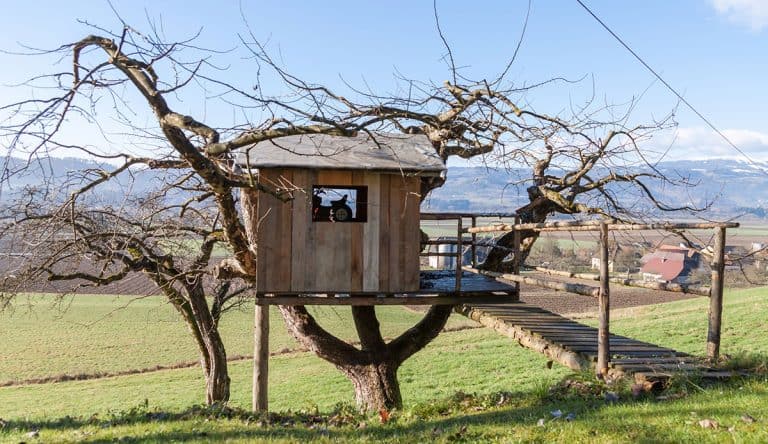
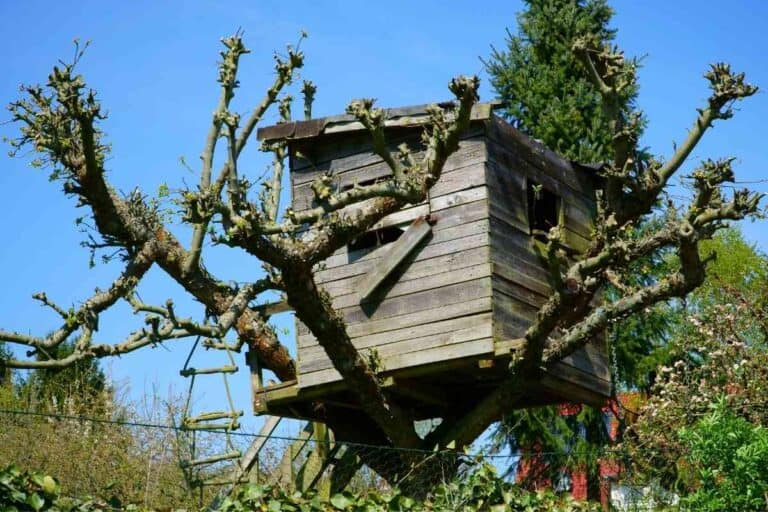
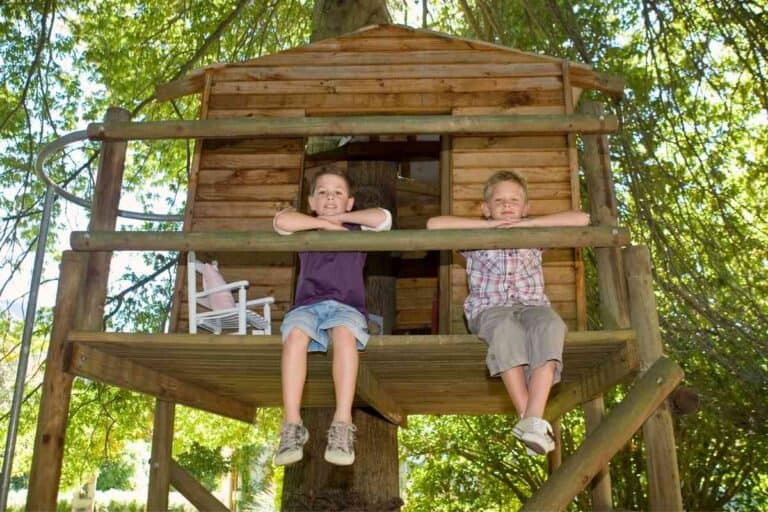
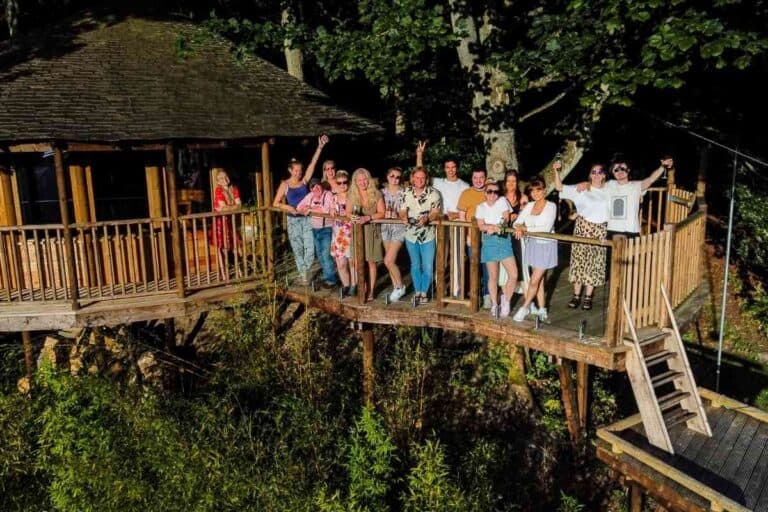
![How Do Treehouses Stay Up? [The Unobvious Answer!]](https://freedomresidence.com/wp-content/uploads/2022/05/How-Do-Treehouses-Stay-Up-1-768x512.jpg)
